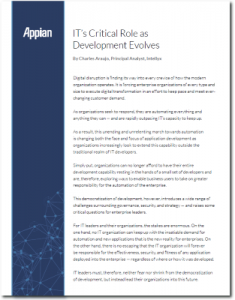Over the last few months, Charles Araujo, Principal Analyst at Intellyx, has produced two important pieces on the evolution of software development.
 His white paper, IT’s Critical Role as Development Evolves, explores the role of IT in a democratized world. Complementing this piece is his webinar, Meeting Customer Expectations in the Digital Age: The Democratization of App Development, in which he explains how this evolution impacts not only the IT organization, but the enterprise as a whole.
His white paper, IT’s Critical Role as Development Evolves, explores the role of IT in a democratized world. Complementing this piece is his webinar, Meeting Customer Expectations in the Digital Age: The Democratization of App Development, in which he explains how this evolution impacts not only the IT organization, but the enterprise as a whole.
Low-code platform provider Appian sponsored both pieces, and to be sure, low-code plays a critical role in this story of evolution. But the overall message of transformation is broader than that.
This is the story of digital transformation overall, transforming organizations end-to-end as they better leverage technology to meet ever-changing customer demands.
The Context for Low-Code
As Araujo points out, simply placing low-code platforms into the historical context of rapid application development (RAD) tools, fourth-generation languages (4GLs), and computer-aided software engineering (CASE) tools misses the bigger picture of the role of low-code in this story of transformation. These earlier trends had some modest successes, but overall, they over-promised and under-delivered – and instead, divisions arose between lines of business and IT.
Historically, IT’s role has been one of optimization and efficiency, and was poorly equipped to deal with the vagaries of line of business application requirements.
As Araujo explains, the solution to this age-old problem isn’t how we divvy up work between lines of business and IT, but rather changing how development happens altogether.
We have a word for this new perspective on development: democratization. Software has become so critical to the success of the organization that we cannot afford to relegate it to a small group of technical people. Instead, everybody must have a hand in how software supports the goals of the enterprise.
The Three Goals
This democratization of software development has three core characteristics: autonomy, collaboration, and automation.
The new world of development must give customer-facing personnel the autonomy to drive application creation that meets ever-changing customer needs. This customer centricity requires business agility, which thus goes hand in hand with autonomy.
Instead of the misalignment between business and IT that has been the bane of every enterprise for so many years, this new paradigm also requires collaboration – collaboration within IT to be sure, but more importantly, across the organization – spanning IT and line of business functions.
This vision of a democratized software development paradigm will never become a reality, however, without automation. IT has been perennially resource constrained – forcing IT leadership to prioritize, since ‘keeping the lights on’ took so much of every dollar.
No more. As IT shifts from its historical cost-management role to its bet-the-company strategic position within digitally transforming enterprises, companies simply cannot afford to prioritize some critical customer-facing efforts over others. And yet, managing costs will always be important. Don’t fool yourself that it will ever be otherwise.
The secret to balancing these strategic priorities: automation. Automation empowers people to be more productive, as the technology removes less valuable tasks from their plates.
In fact, the strategic priorities of digital transformation make automation a must-have – and the companies that automate more effectively are the ones that will succeed in the long run.
The Evolving Role of the Professional Developer
Given the increasing democratization of software development combined with the greater autonomy of people responsible for the customer experience, it might be tempting to think that the role of the professional software developer has become less important.
As Araujo explains, however, the opposite is true: professional developers become increasingly essential, as their role centers on providing strategic value.
Historically, creating software consisted of understanding and delineating the business logic, combined with writing code. With low-code platforms like Appian, automation has largely removed the ‘writing code’ part of this equation.
The result: the role of the professional developer has shifted to a focus on the business logic – that part of software that provides value to the business while also requiring the expertise of a professional developer.
The Intellyx Take
One important caveat: even ‘business logic’ must itself transform in this new paradigm for software development.
If ‘business logic’ conjures up nightmares of requirements documents, as throngs of business analysts pound out one requirement after another, creating a massive tome for developers to implement, then you’re still thinking in an obsolete, waterfall context.
That entire context for software development is no more. Instead, ‘requirements’ consist of a never-ending flux of business priorities and customer desires – and software must rise to the challenge.
In the digital era, everything is changing – and to survive, organizations must adopt change itself as a core competency.
Copyright © Intellyx LLC. As of the time of writing, Appian is an Intellyx customer. Intellyx retains final editorial control of this paper.




This article sums it all. In fact the time is long gone for us not to think of democratizing the application development process.